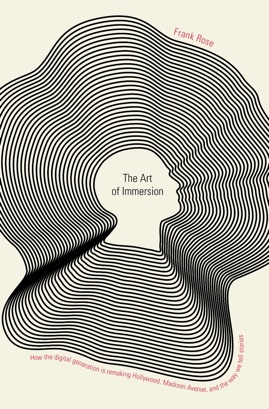From the audience’s impact on the making of LOST to the eerie web promotions for The Dark Knight Returns, our media is becoming more immersive by the day.
WIRED contributing editor Frank Rose noticed this trend and embarked on a years-long voyage to connect the digital dots. His goal was to discover why we’re demanding more and more interactivity and depth in our media experiences, and how advertising agencies, game and film studios and even scientists themselves are scrambling to meet — and dissect — our demand.
 The resulting book is The Art of Immersion, which covers a decade’s worth of anecdotes from media makers like James Cameron (Avatar), Will Wright (The Sims) and Trent Reznor (Nine Inch Nails), as well as a journey inside our brains to help us understand why video games are so addictive, and why our fantasies and our memories may actually be the same thing.
The resulting book is The Art of Immersion, which covers a decade’s worth of anecdotes from media makers like James Cameron (Avatar), Will Wright (The Sims) and Trent Reznor (Nine Inch Nails), as well as a journey inside our brains to help us understand why video games are so addictive, and why our fantasies and our memories may actually be the same thing.
When I tweeted that I was reading the book, Frank Rose noticed and retweeted me, which led to me asking him if he’d be up for a Q&A when I was finished. He agreed. This is where that request led.
Justin Kownacki (JK): What initially sparked your interest in writing The Art of Immersion?
Frank Rose (FR): A series of articles I wrote for WIRED.
The first was about 3-D. In September 2006 I flew to Montreal to interview James Cameron on the set of Journey to the Center of the Earth, the Brendan Fraser movie. He was there because it was the first feature film to use the stereoscopic camera system he had spent several years inventing with Vince Pace. But he didn’t have a lot to do, so I got to talk with him for several hours.
Among other things, we talked about Avatar, which he had in development but Fox had not yet green-lit. He described it as an Edgar Rice Burroughs-type adventure film and said that to his mind, the best way to tell a story like that was to make it almost a fractal experience—something the audience could delve into in powers of ten and the pattern would still hold. The casual fan could just see the movie, but more committed fans could go deeper and deeper and explore the world he created. That idea stayed in my head, but I didn’t really have much to connect it to at that point.
Then, about a year later, I was working on a piece about alternate reality games, focused on 42 Entertainment and the Year Zero experience they’d created with Trent Reznor. Jordan Weisman, the founder of 42, had more or less invented the whole idea of ARGs back in 2001 with The Beast, which he developed with Steven Spielberg as a marketing vehicle for the movie A.I.: Artificial Intelligence. As far as Paramount was concerned it was a marketing vehicle, anyway, because the money to pay for it came out of the marketing budget. But to Weisman it was a way of extending the story.
Weisman was creative director of the games division at Microsoft, which was about to release the Xbox at the time. But he wasn’t really very interested in video games. He’d played Dungeons & Dragons as a kid, and he was really much more interested in that kind of story-based social interaction. So that’s what he set out to create with The Beast—some way to tell a story that was fully interactive, that basically let the audience discover the story and piece it together collectively for themselves. It was participatory storytelling.
 Several months after that I was doing a piece on Hollywood getting into web video. This was in the wake of the writers strike, which left a bunch of writers sitting on their thumbs with nothing to do. Some of them were television writers who’d moved into video games and were looking now for a way to combine the two. Others were people who lived on the fringes of the entertainment business, like the guys behind Prom Queen and Lonelygirl15, the breakout web serial from a couple of years earlier. They all noticed that fans were writing in to characters on the show as if they were real people. Bree from Lonelygirl15 was supposed to be a real person, of course, but even after it came out that she wasn’t, viewers treated her as if she were.
Several months after that I was doing a piece on Hollywood getting into web video. This was in the wake of the writers strike, which left a bunch of writers sitting on their thumbs with nothing to do. Some of them were television writers who’d moved into video games and were looking now for a way to combine the two. Others were people who lived on the fringes of the entertainment business, like the guys behind Prom Queen and Lonelygirl15, the breakout web serial from a couple of years earlier. They all noticed that fans were writing in to characters on the show as if they were real people. Bree from Lonelygirl15 was supposed to be a real person, of course, but even after it came out that she wasn’t, viewers treated her as if she were.
It took the writers and producers awhile to figure out that if people were writing in to fictional characters as if they were real, then the characters ought to write back. It was a blurring of the line between fiction and reality that kind of resembled what you had with ARGs, even though it was ostensibly quite different.
So in the summer of 2008, around the time the web video piece came out, I began to sense that there was something bigger going on—a pattern that I could sort of identify but didn’t completely understand. It had to do with a new way of telling stories that didn’t necessarily happen online but seemed to have an online sensibility about it, so to speak. That’s when I started working on the proposal for the book. Frankly, most people didn’t have a clue what I was talking about. But the people at Norton did, fortunately.
JK: How much of the book’s final form was clear in your original outline, and how many of the chapters and themes were developed throughout the interview and research process?
FR: I wrote the proposal in the fall of 2008, and at that point I had to come up with an outline for the book. Most of the elements that went into the book were in the outline—the focus on people in movies, TV, advertising, and video games, the look at neuroscience, the historical comparisons with earlier kinds of storytelling, all that stuff. But the order changed pretty drastically. My thinking evolved a lot too over the next two years, which is how long it took me to write it.
JK: How were your own presumptions or theories about immersive media challenged or changed through the course of your research?
FR: I’d say they were more confirmed and extended. I mean there were people who challenged these ideas, like Nicholas Carr, who wrote that cover story in The Atlantic, “Is Google Making Us Stupid?”, as I was starting my proposal, and then turned it into a book called The Shallows. We have the same editor, by the way—Brendan Curry. Smart guy.
Carr’s argument was pretty much the opposite of mine. But I never really bought it. I mean there’s a sense in which we’re both right—the web with all its links does encourage a kind of ADD-like behavior if that’s what you’re inclined to do, but I think it also encourages the kind of depth that I’m talking about—the idea I got from Cameron, essentially.
I just don’t see superficiality as the defining aspect of the web—far from it. And to the extent that it’s a defining aspect of our time, I’d say it’s much more a result of television than anything else. Television is completely bound by time. On the Internet, time becomes more or less infinite.
JK: Do you believe audiences been demanding more immersive experiences? Or has this increased immersion in media a natural evolution of digital communications that’s been driven by possibility, rather than any demonstrable audience demand?
FR: I think people have always wanted to immerse themselves in fictions. One thing I delved more and more into as I was working on the book was the idea of historical precedents. At first I didn’t think I would pursue that very far because I thought, who cares that much about the past? But the more I got into it, the more I realized how important it was.
What I realized was that people have always wanted to delve into stories as much as their technology would permit, and that each new technology allowed them to immerse themselves more deeply than the one before. Books were more immersive than the campfire. Movies were more immersive than books. Television was more immersive, or at least more addictive, than the movies. And so on. The Internet is just the next stage in the continuum.
JK: What’s being lost at the expense of increased immersion?
FR: Hmm. Increased superficiality?
JK: How have the companies and advertising agencies you’ve spoken with adapted to the immersive trend? Do they see it as a positive? Do they believe it’s a permanent shift in the way customers and audiences engage with their messaging and products?
FR: It’s either/or. There’s a very significant number of people in the ad industry who see this as a necessity, or an opportunity, or both. And there’s a lot who wish it would all go away so they could just keep on making 30-second spots for TV. There’s no question that engaging directly with customers is a lot more complicated. But there’s no going back. Sorry.
JK: Although the book is densely packed with anecdotes and observations, I can’t help but feel like there’s probably as much left OUT of this book as there is included IN it. Much of it reads like a blog post, in which allusions to related news items and major players would benefit from a text link so readers could explore the tangents even further. What was the editing process for this book like, and how did you make choices about what (and how much) to leave in / excise?
FR: You’re right—there’s a lot that was left out. But that’s always the case when you put a story together. Most of the things that were left out didn’t make it because they never quite gelled. There was an amazing and totally unreported ad campaign that I couldn’t use because the client wouldn’t give the okay. And I very much wanted to include Battlestar Galactica, but I was never quite able to schedule time with the exec producers, Ron Moore and David Eick.
In the end, that probably would have been redundant anyway. The point was to produce a sampling, not an encyclopedia. Basically you just chase everything that comes across your radar and hope that you catch enough of it to make the whole thing work.
That said, there wasn’t that much that was actually excised. The big challenge was to tie it all together. When I turned in the first draft, each chapter was a series of anecdotes that was more or less disconnected from what was in all the other chapters. I knew how it was all supposed to fit together, but it wasn’t obvious to anybody else. So I had to connect a lot of dots.
JK: Most chapters follow the same format: introduce a protagonist with a problem, then intertwine two related narratives that complement that chapter’s core theme. Was that design a conscious choice, or an intentional nod to traditional three-act structure?
FR: Probably it was an unconscious choice.
JK: Considering this immersive trend is ongoing, and you could have potentially kept gathering an endless amount of related interviews, how did you decide when the book was “done”?
FR: That’s what deadlines are for.
You’re right to suggest it was kind of arbitrary. This reinvention of storytelling is very much an ongoing process. I could have waited until it was all over, several years from now, but that would have been a very different book. Plus it probably wouldn’t be apparent that it was all over until five or ten years after that. The point of this book was to document a transition, what I think is a very historic transition, as it was happening.
My publisher gave me a deadline, and they did their part by agreeing to crash the book–to produce it in six months rather than 12 or 18, which is the norm. That’s fine for biographies of dead people, but not for something like this. So I turned in the complete manuscript in August a year ago and my editor got it back to me in a couple of weeks, and I was still making revisions as it went into copyediting. I was adding sections to a couple of chapters as late as October. It was “done” on the day it had to go to press. That was in November, and we got books back two months later.
Meanwhile, as you say, the trend is ongoing. That’s what the blog is for. Hopefully the book provides a framework, and the blog becomes a way to follow the trend wherever it might lead from here.
********
Thanks to Frank Rose for deconstructing his own thought process behind the book. As a writer, I’m always interested in how a finished piece comes together. And as a creator (and user) of media, I’m always interested in what the new possibilities are, and how audiences are engaging with what we make.
From a book review standpoint, I’ll say this about The Art of Immersion: it’s filled with compelling stories that caused me to ask thought-provoking questions.
Anyone who works in social media or pop culture will be at least generally familiar with most of Rose’s subject matter, but seeing it all strung together under the umbrella of “immersion” incites the awareness of behavior patterns that we might not detect simply by judging each bit of media on its own.
I do think the book takes its premise — that increasing media immersion is inevitable — a bit too much for granted at the expense of asking “why” (or “really?”). That said, it’s impossible to read The Art of Immersion and not start to see mass media — and the economy that drives it — differently.
If we really do expect increasingly immersive experiences from our media, it’s worth exploring how and why those experiences “work” (or don’t), and why the best of them transcend the trappings of advertising or art on their way to becoming a world unto themselves.
Frank Rose may not have covered all of that ground in The Art of Immersion (and really, who could?), but he definitely aimed his sled in the right direction, and I look forward to seeing it pick up speed as he explores further stories and studies in these topics on his blog.
Got email? Subscribe to my blog and you’ll never miss a post!


3 Comments
2569025360 · December 6, 2011 at 6:16 am
Outlet Monclers
Moncler Outlet
2012 New Moncler
Giacche Donna Moncler
Gilet Moncler donna
Moncler Bambini Giacche
Moncler donna Cappotti
Moncler Sciarpa e cappello
Moncler Sciarpa e cappello
Moncler uomo Vest
Moncler Gilet Donne
Moncler Gilet Uomo
Moncler Cappotti Donne
Moncler Piumini Uomot
2569025360 · December 2, 2011 at 11:15 pm
Outlet Monclers
Moncler Outlet
2012 New Moncler
Giacche Donna Moncler
Gilet Moncler donna
Moncler Bambini Giacche
Moncler donna Cappotti
Moncler Sciarpa e cappello
Moncler Sciarpa e cappello
Moncler uomo Vest
Moncler Gilet Donne
Moncler Gilet Uomo
Moncler Cappotti Donne
Moncler Piumini Uomot
10 Things That Changed My Life in 2011 / Justin Kownacki · December 26, 2011 at 3:03 am
[…] The Art of Immersion, by Frank Rose (read my Q&A with the author) […]